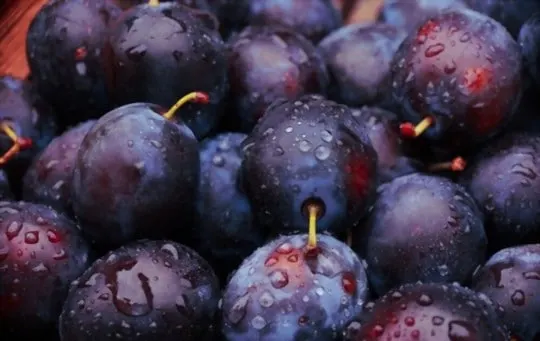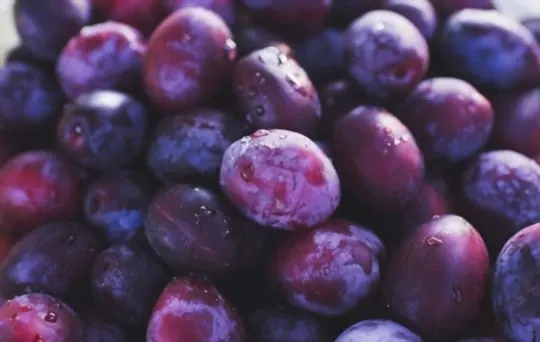Plums are a juicy and sweet fruit that is in season from May to October.
They have an intense sweetness and tartness, which means many different people can enjoy them.
Plums have many health benefits, such as being an excellent source of vitamin C and antioxidants.
Plums can be eaten fresh or used to make jams or pies.
This blog post talks about how long plums last and how you can store them for future use.
What are Plums?

Plums are a fruit that belongs to the genus Prunus.
It can be found in many colors, including black, purple, and red.
The most common variety of plums is the Italian or Damson plum.
Plums are native to Asia but have been cultivated in Europe for centuries.
They grow in temperate areas such as China, Japan, and the United States.
Plum trees produce roundish fruits with velvety skin when ripe; they vary from about 1-2 inches long up to 6 inches long, depending on the type of plums.
Plums are healthy and nutritious fruit that contains Vitamin C, fiber, and potassium.
They also offer many antioxidants to help fight free radicals in the body.
The antioxidant levels of plums usually exceed those found in other fruits such as apples or oranges.
Although plums can be consumed raw, they are most commonly cooked down into jams and jelly-like sauces.
This requires an additional amount of sugar due to the high concentration of natural sugars in ripe plum juices.
The fresh plum sauce can also be made from cooking fresh diced plums with water until soft, then adding sugar to taste.
This variation is prevalent during the late summer months when plums are abundant.
How to Store Plums?

It is essential to know how to store plums properly to stay fresh and be enjoyed for a long time.
Some people enjoy eating them right away, but others prefer to wait until the plums have ripened or even been canned.
If you are storing plums to eat them later, then it’s best if you follow these guidelines:
Choose firm, unblemished fruit with no indentations or spots on the skin.
- Store in a cool place like the fridge or a pantry that stays below 60 degrees Fahrenheit at all times (plum will spoil more quickly at warm temperatures).
- Do not wash before storing unless there is dirt on the surface of the plum.
- Store plums in a paper bag to keep them separate and prevent bruising.
- Don’t store plums near other fruits or vegetables that give off ethylene gas, like apples or potatoes, because the high levels of this noxious substance will cause your plum’s flavor to deteriorate faster.
Plum is an excellent fruit that can be eaten on its own and combined with many different recipes for baking and cooking.
To enjoy it at its best, follow these tips when storing.
How Long Do Plums Last?

Many factors affect the lifespan of plums, but in general, they will last longer when stored at the proper temperature.
Ensure to store them in a bag to keep the moisture and ethylene gas from spoiling their quality, or place an apple among other fruits that emit less of this type.
| Storage Method | Shelf Life |
|---|---|
| Ripe Plums | 3-5 days in the fridge |
| Unripe Plums | 2-3 days at room temperature, 3-5 days in the fridge |
| Dried Plums | 6-12 months at room temperature, refrigeration optional |
The shelf life of plums can vary depending on their ripeness and storage method. Here is a breakdown:
- Ripe Plums: Fully ripe plums will last for about 3 to 5 days when stored in the refrigerator. It is recommended to consume them within this timeframe for optimal freshness.
- Unripe Plums: If the plums are unripe, you can store them on the counter until they ripen. Once ripe, you can leave them at room temperature for 2 to 3 days or refrigerate them for 3 to 5 days to extend their shelf life.
- Dried Plums (Prunes): Dried plums, also known as prunes, have a longer shelf life compared to fresh plums. Properly stored dried plums can last for about 6 to 12 months at normal room temperature. In hot and humid environments, refrigeration may be beneficial to maintain their quality.
It is important to note that these are general guidelines and the shelf life can vary depending on factors such as the freshness of the plums, storage conditions, and preservatives used. Always check for signs of spoilage, such as mold or an off smell, before consuming plums.
You can also freeze plums as a long-term option. To freeze, wash the plums and pat them dry.
Slice each plum lengthwise in half or quarters before freezing to allow for even thawing.
Place cut fruit into a sealable freezer bag with all of the air pressed out, then place it flat on a tray until frozen.
These will last in your freezer for about 5 – 6months.
When you are ready to use them again, remove them from the plastic packaging and let them thaw at room temperature for approximately 30 minutes or so before consuming them.
What Happens if You Eat a Bad Plum?

A plum is a stone fruit that’s closely related to the apricot.
Plums come in many varieties, including greengage plums and Santa Rosa plums.
Plum flavors range from sweet to sour with tartness levels up to about 15° on the pH scale.
A lot of people like them raw or cooked into jams and sauces because they’re so versatile.
But not everyone likes their flavorsome find it too strong for their liking, while others say they have an overwhelming chemical taste when eaten straight out of hand.
Sometimes even when cooking, there can be an odd aftertaste lingering around your mouth long after you’ve finished eating.
Something doesn’t feel right, but you don’t know what it might be.
So what is the cause of this? Many things can happen when you eat a bad plum, depending on how it was picked and stored.
A lot of people believe that they don’t have any flaws in them because sometimes, even if they’re mushy or squishy to touch, their outer skin looks perfect – which should tell you something about the condition inside.
For example:
- The sugar content might be too high for your taste buds, like biting into an incredibly juicy peach but mixed with a bitter tanginess from not being able to ripen before picking entirely.
- It could also mean there’s been no time for enzymes to break down complex sugars (which give the fruit its sweetness) while sitting around waiting to be eaten.
- It could also be that the plum is a non-sweet variety and you’re just not used to it, so your taste buds are having trouble adjusting.
Many people don’t know what this means until they start researching into it – which can lead them down a fascinating rabbit hole of information on fruit acids, sugars, pH balances, and more.
But sometimes, all we need to do is find another one or wait for their next batch from the farm store when they’ve had time to ripen properly.
How to Tell if Plums are Bad?

It’s not always easy to judge whether the product is fresh or spoiled.
Plums are more difficult fruits to figure out because they have thin skin and are so delicate.
It’s essential to know how old your plums are since they’re in season for just a short time each year.
Here are some ways you can tell if your plums have gone bad:
They smell funky or fermented-like, indicating bacteria has gotten into them.
Their skin starts to wrinkle or peel away from the flesh inside, which means that air has begun rotting them from the inside out.
If you press on the skin and it leaves an indentation, that means they’re old.
Their flesh turns brown or starts to break down into mush when cut open because bacteria has begun working its way through them from the inside out.
A rotten plum will have a purple and white film covering its insides – this indicates mold growing on top of spoilage.
The juice will turn dark in color and smell funky if overripe plums are left too long.
The same goes for any fruit with thin skin like grapes, berries, cherries, etc.
It’s important not to wash your produce before storing it because you’ll wash away the natural coating on them that keeps bacteria at bay.
Conclusion
In conclusion, you can enjoy some of these best practices for storing plums.
The key is to keep the plum in a cool place, such as your refrigerator.
Be sure not to store them near other produce that’s going bad or any strong-smelling foods like onions and garlic.
You should also watch out if you have pets around because they might find discarded fruit interesting enough to eat.
The next time there are too many of this type of fruit on hand, be sure to follow these tips so you won’t end up throwing away good food needlessly.

How Long Do Plums Last? Do Plums Go Bad?
Ingredients
- Plums
- Air-tight containers or Ziplock bags
- Labels and markers
Instructions
- Read the guide thoroughly to learn how long it lasts.
- Label your container with the content and date and keep track of how much you’re using!
- Make sure to store in an airtight container in a cool, dark place (pantry or fridge).
- If frozen, thaw in the fridge before use. Always check for signs of spoilage before using.
